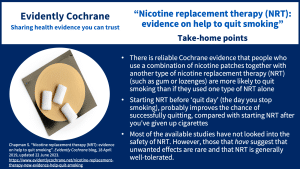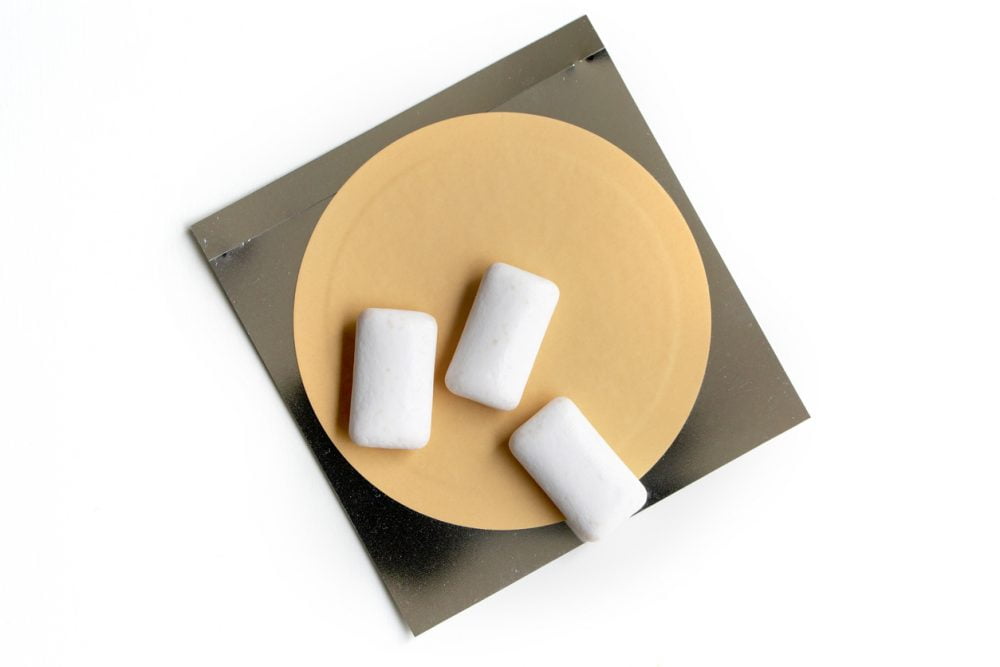In this blog for people wanting to quit smoking, Sarah Chapman shares the latest Cochrane evidenceCochrane Reviews are systematic reviews. In systematic reviews we search for and summarize studies that answer a specific research question (e.g. is paracetamol effective and safe for treating back pain?). The studies are identified, assessed, and summarized by using a systematic and predefined approach. They inform recommendations for healthcare and research. on the effectivenessThe ability of an intervention (for example a drug, surgery, or exercise) to produce a desired effect, such as reduce symptoms. of nicotine replacement therapy.
Page last updated 22 June 2023 to reflect the latest evidence.
Take-home points

People who use a combination of nicotine patches together with another type of nicotine replacement therapy (NRT) (such as gum or lozenges) are more likely to quit smoking than if they used one type of NRT alone. That’s the headline message backed by high-quality evidence, in the Cochrane ReviewCochrane Reviews are systematic reviews. In systematic reviews we search for and summarize studies that answer a specific research question (e.g. is paracetamol effective and safe for treating back pain?). The studies are identified, assessed, and summarized by using a systematic and predefined approach. They inform recommendations for healthcare and research. Different doses, durations and modes of delivery of nicotine replacement therapy for smoking cessation (published June 2023).
This is a really important finding both for people buying nicotine replacement products to help them quit and for those commissioning NHS stop smoking services.
What is nicotine replacement therapy (NRT)?
We already have evidence that nicotine replacement therapy can help smokers to quit, from the earlier Cochrane Review Nicotine replacement therapy versus control for smoking cessation (published May 2018). It does this by replacing the nicotine they are used to getting from tobacco, getting it to the brain through a variety of routes. NRT is available as sprays (into the nose or mouth), inhalers, gum, lozenges, tablets and skin patches. But which way is best?
New evidence about NRT
A team of authors did a systematic review with the aim of answering this question. They looked for all the relevant research studies and found 68 trialsClinical trials are research studies involving people who use healthcare services. They often compare a new or different treatment with the best treatment currently available. This is to test whether the new or different treatment is safe, effective and any better than what is currently used. No matter how promising a new treatment may appear during tests in a laboratory, it must go through clinical trials before its benefits and risks can really be known. involving 43,327 smokers – mostly adults who wanted to quit. Most smoked 20 or more cigarettes a day at the start.
More is better
They found that people using a nicotine patch together with another type of NRT, such as lozenges, were more likely to quit smoking for six months or more than people using just one type of NRT.
Does the dose matter?
People who use higher‐dose nicotine patches (25 mg patches worn for 16 hours, or 21 mg patches worn for 24 hours) are probably more likely to quit smoking compared to those using lower‐dose patches (15 mg patches worn for 16 hours or 14 mg patches worn for 24 hours). However, there is probably little to no difference between using 42 mg or 44 mg patches compared with 21 mg or 22 mg (24‐hour) patches.
Starting NRT before quitting may help
Starting NRT before ‘quit day’ (the day on which someone stops smoking), probably improves the chance of success compared with starting NRT after you’ve given up cigarettes.

Is NRT safe?
It’s always important to know about the potential harms as well as benefits of any treatmentSomething done with the aim of improving health or relieving suffering. For example, medicines, surgery, psychological and physical therapies, diet and exercise changes.. Most of the studies didn’t look at this! Those that did suggest that unwanted effects are rare and that NRT is generally well-tolerated. The evidence also suggests that risks may not be increased when more than one type of NRT is used. However, there is insufficient evidence to know whether different types or methods of NRT delivery lead to more harmful effects.
Where does this leave us?
This high-quality evidence clearly signposts that the most effective way to use NRT is to use a combination of two products at once, a patch and a fast-acting form such as gum, nasal spray or lozenge. Quitting this way increases the chances of you stopping smoking altogether.
However there are questions that the existing research doesn’t answer, including how long NRT should be used for, and whether it makes a difference to successful quitting if smokers pay for NRT or have it provided for free. We also need better reporting about potential harms of NRT. More research is also needed in people smoking fewer than 15 cigarettes a day, or more than 40 cigarettes a day, and in younger age groups.
This leaves plenty of work for researchers to do. For smokers wanting to quit, it’s good to know that this review has some high-quality evidence to inform their decisions about using NRT to help them.
References:
Hartmann‐Boyce J, Chepkin SC, Ye W, Bullen C, Lancaster T. Nicotine replacement therapy versus control for smoking cessation. Cochrane Database of Systematic ReviewsIn systematic reviews we search for and summarize studies that answer a specific research question (e.g. is paracetamol effective and safe for treating back pain?). The studies are identified, assessed, and summarized by using a systematic and predefined approach. They inform recommendations for healthcare and research. 2018, Issue 5. Art. No.: CD000146. DOI: 10.1002/14651858.CD000146.pub5.
Theodoulou A, Chepkin SC, Ye W, Fanshawe TR, Bullen C, Hartmann-Boyce J, Livingstone-Banks J, Hajizadeh A, Lindson N. Different doses, durations and modes of delivery of nicotine replacement therapy for smoking cessation. Cochrane Database of Systematic Reviews 2023, Issue 6. Art. No.: CD013308. DOI: 10.1002/14651858.CD013308.pub2.
Join the conversation on Twitter with @CochraneUK @CochraneTAG @SarahChapman30 or leave a comment on the blog. Please note, we cannot give specific medical advice and do not publish comments that link to individual pages requesting donations or to commercial sites, or appear to endorse commercial products. We welcome diverse views and encourage discussion but we ask that comments are respectful and reserve the right to not publish any we consider offensive. Cochrane UK does not fact check – or endorse – readers’ comments, including any treatments mentioned.
Sarah Chapman has nothing to disclose.



I have successfully quit after 37 years. I used a patch for one week, then lozenges for another three years, during which I learned to live without cigarettes. This included drinking alcohol regularly without any cigarettes. None.
In the beginning I used a half of one NiQuitin 21mg per day pressed on firmly for one minute, reduced to one third of that at night for sleep (one sixth of a patch). Daily, after my evening meal I showered, but used no shampoo or underarm deodorant, they both hinder the ‘sweating out’ of harmful smoking metabolites and this is essential to restore balance. Soap only on scalp, I’m afraid.
After 7 days of this routine, I woke up on day 8 and used lozenges only. They were excellent, they did their job and I loved having them around for the next three years.
I finally gave up the lozenges one month ago, and I’ve never been happier. I simply stopped dead, used the cleansing routine again (showers, no shampoo) and used sugar free mints. This had been an overwhelming success for me, and I really felt I had to share, if it can help even one person.
I had previously tried many times to use NRT, and my methods are the result of much trial and error, but this works. I am male, but I believe that women should start NRT at the first sign of menstruation, in order that they should rid the body of any harmful metabolites in the old uterine lining.
OK thanks for your time.